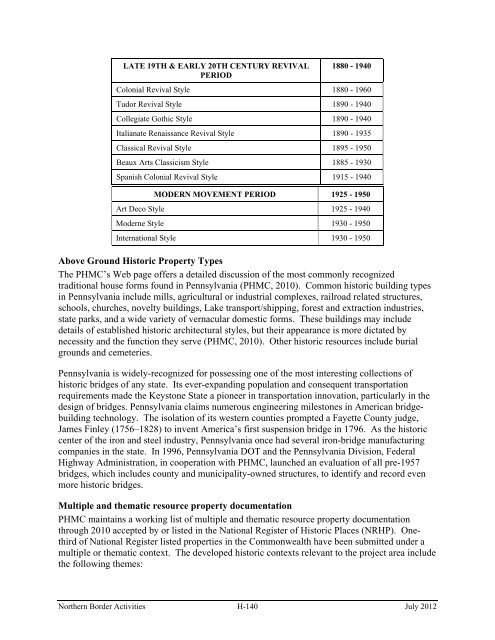Appendix H - Historical Archaeological and ... - CBP.gov
Appendix H - Historical Archaeological and ... - CBP.gov
Appendix H - Historical Archaeological and ... - CBP.gov
Create successful ePaper yourself
Turn your PDF publications into a flip-book with our unique Google optimized e-Paper software.
LATE 19TH & EARLY 20TH CENTURY REVIVAL<br />
PERIOD<br />
1880 - 1940<br />
Colonial Revival Style 1880 - 1960<br />
Tudor Revival Style 1890 - 1940<br />
Collegiate Gothic Style 1890 - 1940<br />
Italianate Renaissance Revival Style 1890 - 1935<br />
Classical Revival Style 1895 - 1950<br />
Beaux Arts Classicism Style 1885 - 1930<br />
Spanish Colonial Revival Style 1915 - 1940<br />
MODERN MOVEMENT PERIOD 1925 - 1950<br />
Art Deco Style 1925 - 1940<br />
Moderne Style 1930 - 1950<br />
International Style 1930 - 1950<br />
Above Ground Historic Property Types<br />
The PHMC’s Web page offers a detailed discussion of the most commonly recognized<br />
traditional house forms found in Pennsylvania (PHMC, 2010). Common historic building types<br />
in Pennsylvania include mills, agricultural or industrial complexes, railroad related structures,<br />
schools, churches, novelty buildings, Lake transport/shipping, forest <strong>and</strong> extraction industries,<br />
state parks, <strong>and</strong> a wide variety of vernacular domestic forms. These buildings may include<br />
details of established historic architectural styles, but their appearance is more dictated by<br />
necessity <strong>and</strong> the function they serve (PHMC, 2010). Other historic resources include burial<br />
grounds <strong>and</strong> cemeteries.<br />
Pennsylvania is widely-recognized for possessing one of the most interesting collections of<br />
historic bridges of any state. Its ever-exp<strong>and</strong>ing population <strong>and</strong> consequent transportation<br />
requirements made the Keystone State a pioneer in transportation innovation, particularly in the<br />
design of bridges. Pennsylvania claims numerous engineering milestones in American bridgebuilding<br />
technology. The isolation of its western counties prompted a Fayette County judge,<br />
James Finley (1756–1828) to invent America’s first suspension bridge in 1796. As the historic<br />
center of the iron <strong>and</strong> steel industry, Pennsylvania once had several iron-bridge manufacturing<br />
companies in the state. In 1996, Pennsylvania DOT <strong>and</strong> the Pennsylvania Division, Federal<br />
Highway Administration, in cooperation with PHMC, launched an evaluation of all pre-1957<br />
bridges, which includes county <strong>and</strong> municipality-owned structures, to identify <strong>and</strong> record even<br />
more historic bridges.<br />
Multiple <strong>and</strong> thematic resource property documentation<br />
PHMC maintains a working list of multiple <strong>and</strong> thematic resource property documentation<br />
through 2010 accepted by or listed in the National Register of Historic Places (NRHP). Onethird<br />
of National Register listed properties in the Commonwealth have been submitted under a<br />
multiple or thematic context. The developed historic contexts relevant to the project area include<br />
the following themes:<br />
Northern Border Activities H-140 July 2012
















